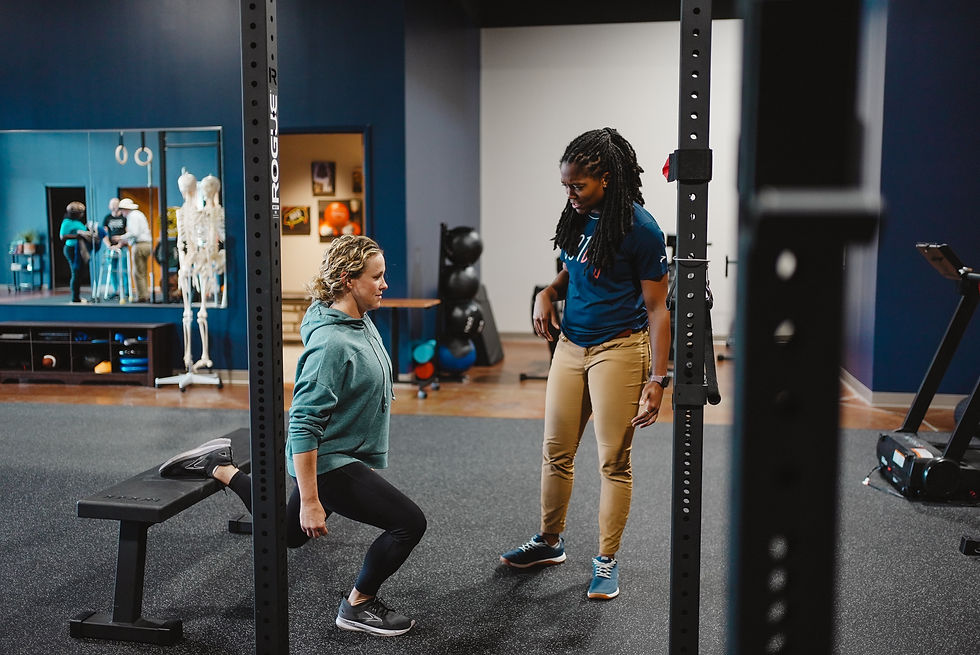Rebuild Your Stride: How Physical Therapy Can Help You Overcome Chronic Running Injuries
- 901PT

- Dec 11, 2024
- 3 min read
Updated: Jan 21
Running is a great way to stay fit and healthy, but chronic injuries can sideline even the most dedicated runners. From shin splints to knee pain, these issues often stem from repetitive stress, muscle imbalances, or improper running mechanics. Physical therapy provides a solution, helping runners address these underlying causes, rebuild their stride, and return to running pain-free. At 901PT in Memphis, TN, physical therapists offer specialized programs designed to support runners in overcoming chronic injuries and maintaining a healthy stride.
Identifying the Root Causes of Chronic Running Injuries
Many running injuries are the result of repetitive stress, poor form, or weaknesses in certain muscle groups. Physical therapists at 901PT assess each runner’s unique biomechanics and identify issues like overpronation, muscle imbalances, or lack of flexibility. By targeting the root causes of pain, physical therapy doesn’t just treat symptoms but also helps runners make long-term improvements in their stride.
This comprehensive approach allows Memphis runners to better understand their movement patterns, enabling them to adjust and avoid future injuries. By addressing the underlying causes of discomfort, physical therapy supports more efficient and pain-free running.
More articles from our Memphis physical therapy blog:
Improving Strength for Enhanced Stability and Performance
Weakness in muscles such as the glutes, hips, and core can lead to instability, impacting the knees, ankles, and lower back. Physical therapy includes strength-building exercises that target these key areas, improving stability and reducing strain on vulnerable joints. This improved stability supports a stronger, more efficient stride, allowing runners to perform better and avoid common injuries.

At 901PT, physical therapists design strength-focused programs tailored to each runner’s specific needs. With a foundation of balanced muscle strength, runners in Memphis can rebuild their stride with confidence, knowing they’re less likely to experience recurring pain.
Enhancing Flexibility and Mobility for a Smooth Stride
Flexibility and mobility are essential for a smooth, unrestricted stride. Tight muscles, especially in the calves, hamstrings, and hip flexors, can limit range of motion and lead to compensation patterns that increase injury risk. Physical therapy incorporates targeted stretches and mobility exercises that loosen tight areas, allowing runners to move more freely and efficiently.
In Memphis, 901PT emphasizes flexibility as part of each runner’s recovery plan. By addressing stiffness and improving range of motion, runners can maintain proper form, reduce strain, and enjoy a more comfortable, natural stride.
Correcting Running Mechanics for Injury Prevention
Poor running mechanics, such as overstriding or heel striking, can lead to chronic pain and injuries. Physical therapists at 901 PT analyze each runner’s form, identifying any issues and providing corrective exercises that promote a safer, more effective stride. Small adjustments in mechanics can make a big difference, reducing impact forces and protecting joints from repetitive stress.
For Memphis runners, this focus on form is invaluable for long-term health. By developing safe and efficient mechanics, physical therapy helps runners protect their bodies and enjoy the sport without pain.
Frequently Asked Questions
How does physical therapy help with chronic running injuries? Physical therapy targets the root causes of injuries, such as muscle imbalances, flexibility issues, and poor form. By addressing these areas, therapists help runners build a strong, efficient stride.
Can physical therapy prevent future running injuries? Yes, physical therapy includes strengthening, flexibility, and form correction exercises that reduce injury risk, enabling runners to maintain a healthy running routine.
What are common running injuries treated with physical therapy? Physical therapy treats a variety of running injuries, including shin splints, IT band syndrome, plantar fasciitis, and runner’s knee, using customized recovery plans.
How long does it take to recover from a chronic running injury with physical therapy? Recovery time varies based on the injury’s severity and the runner’s consistency with therapy. Physical therapists can provide a tailored timeline based on individual progress.
Is physical therapy beneficial for both beginner and experienced runners? Absolutely. Physical therapy supports runners of all levels by addressing injuries, improving mechanics, and building strength for a sustainable running career.



